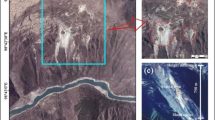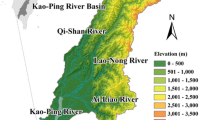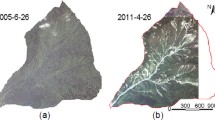Abstract
A mountain disaster chain is a complex system that consists of several sub-disasters and can result in high casualties or serious economic loss. In this study of the mountain disaster chain linking landslides, barrier lakes, and outburst floods, a system model is presented for preliminary use. This system model consists of several depth-averaged models to simulate the movements of sub-disasters. Some factors that influence the movement of each sub-disaster are considered, such as basal pore pressure and sediment transport. Furthermore, the critical conditions that influence the transition between subordinate disaster and superior disaster are studied. To validate the feasibility of the proposed system model, the Yigong mountain disaster chain is simulated as a case study. Comparisons between field observations and numerical results confirm the validity of the model.





(modified from Google Earth, 2016)

obtained from Google Earth, 2016


obtained from Google Earth, 2016

obtained from Google Earth, 2016

Similar content being viewed by others
References
Abe K, Konagai K (2016) Numerical simulation for runout process of debris flow using depth-averaged material point method. Soils Found 56(5):869–888
Adduce C, Sciortino G, Proietti S (2011) Gravity currents produced by lock exchanges: experiments and simulations with a two-layer shallow-water model with entrainment. J Hydraul Eng 138(2):111–121
Audusse E, Bouchut F, Bristeau MO, Klein R, Perthame BT (2004) A fast and stable well-balanced scheme with hydrostatic reconstruction for shallow water flows. SIAM J Sci Comput 25(6):2050–2065
Bollermann A, Chen G, Kurganov A, Noelle S (2013) A well-balanced reconstruction of wet/dry fronts for the shallow water equations. J Sci Comput 56(2):267–290
Bunya S, Kubatko EJ, Westerink JJ, Dawson C (2009) A wetting and drying treatment for the Runge–Kutta discontinuous Galerkin solution to the shallow water equations. Comput Methods Appl Mech Eng 198(17):1548–1562
Cao Z (1999) Equilibrium near-bed concentration of suspended sediment. J Hydraul Eng 125(12):1270–1278
Cao Z, Pender G, Wallis S, Carling P (2004) Computational dam-break hydraulics over erodible sediment bed. J hydraul Eng 130(7):689–703
Cao Z, Yue Z, Pender G (2011) Landslide dam failure and flood hydraulics. Part II: coupled mathematical modelling. Nat Hazards 59(2):1021–1045
Castro M, Frings JT, Noelle S, Parés C, Puppo G (2012) On the hyperbolicity of two-and three-layer shallow water equations. In: Li T, Jiang S (eds) Hyperbolic problems. Theory, numerics and applications, World Scientific, vol 1. pp 337–345
Castro-Díaz MJ, Fernández-Nieto ED, González-Vida JM, Parés-Madronal C (2011) Numerical treatment of the loss of hyperbolicity of the two-layer shallow-water system. J Sci Comput 48(1–3):16–40
Chang TJ, Kao HM, Chang KH, Hsu MH (2011) Numerical simulation of shallow-water dam break flows in open channels using smoothed particle hydrodynamics. J Hydrol 408(1):78–90
Chen LZ (2016) Three-dimensional numerical simulation of Yigong rock avalanche using particle flow code. Master’s thesis, Southwest Jiaotong University
Chen SC, Peng SH (2006) Two-dimensional numerical model of two-layer shallow water equations for confluence simulation. Adv Water Resour 29(11):1608–1617
Delaney KB, Evans SG (2015) The 2000 Yigong landslide (Tibetan Plateau), rockslide-dammed lake and outburst flood: review, remote sensing analysis, and process modelling. Geomorphology 246:377–393
Domnik B, Pudasaini SP, Katzenbach R, Miller SA (2013) Coupling of full two-dimensional and depth-averaged models for granular flows. J Nonnewton Fluid Mech 201:56–68
Faeh R (2007) Numerical modeling of breach erosion of river embankments. J Hydraul Eng 133(9):1000–1009
Fernández-Nieto ED, Bouchut F, Bresch D, Diaz MC, Mangeney A (2008) A new Savage–Hutter type model for submarine avalanches and generated tsunami. J Comput Phys 227(16):7720–7754
Gosse L (2000) A well-balanced flux-vector splitting scheme designed for hyperbolic systems of conservation laws with source terms. Comput Math Appl 39(9–10):135–159
Gray JMNT, Edwards AN (2014) A depth-averaged-rheology for shallow granular free-surface flows. J Fluid Mech 755:503–534
Hou J, Liang Q, Simons F, Hinkelmann R (2013) A 2D well-balanced shallow flow model for unstructured grids with novel slope source term treatment. Adv Water Resour 52:107–131
Hu MJ, Wang FW, Cheng QG (2009) Formation of tremendous Yigong landslide based on high-speed shear tests. J Geotech Eng 31(10):1602–1606
Huang YD (2014) The nonlinear response characteristics of transmission system in mountain disaster chain. PhD thesis, Southwest Jiaotong University, China
Iverson RM, Denlinger RP (2001) Flow of variably fluidized granular masses across three-dimensional terrain: 1. Coulomb mixture theory. J Geophys Res Solid Earth 106(B1):537–552
Iverson RM, George DL (2014) A depth-averaged debris-flow model that includes the effects of evolving dilatancy. I. Physical basis. In: Proceedings of royal society of America, vol 470(2170). The Royal Society, p 20130819
Jin S (2001) A steady-state capturing method for hyperbolic systems with geometrical source terms. ESAIM Math Model Numer Anal 35(4):631–645
Kim J, LeVeque RJ (2008) Two-layer shallow water system and its applications. In: Proceedings of the twelth international conference on hyperbolic problems, Maryland
Kraus NC (2003) Analytical model of incipient breaching of coastal barriers. Coast Eng J 45(04):511–531
Kuo CY, Tai YC, Bouchut F, Mangeney A, Pelanti M, Chen RF, Chang KJ (2009) Simulation of Tsaoling landslide, Taiwan, based on Saint Venant equations over general topography. Eng Geol 104(3):181–189
LeVeque RJ (2002) Finite volume methods for hyperbolic problems, vol 31. Cambridge university press, Cambridge
Li S, Duffy CJ (2011) Fully coupled approach to modeling shallow water flow, sediment transport, and bed evolution in rivers. Water Resour Res 47(3):W03508. https://doi.org/10.1029/2010WR009751
Li S, Duffy CJ (2012) Fully-coupled modeling of shallow water flow and pollutant transport on unstructured grids. Proc Environ Sci 13:2098–2121
Li J, Chen NS, Ouyang CJ, Li AG, Zuo XL (2017) Volume of loose materials and the analysis of possibility of blocking and dam break triggered by debris flows in Zhamunonggou. J Catastophol 32(1):80–84
Liang Q (2010) Flood simulation using a well-balanced shallow flow model. J hydraul Eng 136(9):669–675
Liang Q, Borthwick AG (2009) Adaptive quadtree simulation of shallow flows with wet–dry fronts over complex topography. Comput Fluids 38(2):221–234
Liu W, Xiao S, Sui Y, Zhou J, Gao H (2006) Analysis of natural disaster chain and chain-cutting disaster mitigation mode. Yanshilixue Yu Gongcheng Xuebao/Chin J Rock Mech Eng 25:2675–2681
Ma G, Kirby JT, Hsu TJ, Shi F (2015) A two-layer granular landslide model for tsunami wave generation: theory and computation. Ocean Model 93:40–55
Mergili M, Schratz K, Ostermann A, Fellin W (2013) A GRASS GIS implementation of the Savage-Hutter avalanche model and its application to the 1987 Val Pola event. In: Margottini C, Canuti P, Sassa K (eds) Landslide science and practice. Springer, Berlin, pp 367–373
Meyer-Peter E, Muller R (1948) Formulas for bed-load transport. In: Proceedings of the 2nd congress of international association of hydraulic research. Stockholm, pp 39–64
Morales-Hernández M, García-Navarro P, Burguete J, Brufau P (2013) A conservative strategy to couple 1D and 2D models for shallow water flow simulation. Comput Fluids 81:26–44
Nielsen P (1992) Coastal bottom boundary layers and sediment transport, vol 4. World Scientific Publishing Co Inc, Singapore
Nikolos IK, Delis AI (2009) An unstructured node-centered finite volume scheme for shallow water flows with wet/dry fronts over complex topography. Comput Methods Appl Mech Eng 198(47):3723–3750
Norio O, Ye T, Kajitani Y, Shi P, Tatano H (2011) The 2011 eastern Japan great earthquake disaster: overview and comments. Int J Disaster Risk Sci 2(1):34–42
Osti R, Egashira S (2009) Hydrodynamic characteristics of the Tam Pokhari Glacial Lake outburst flood in the Mt. Everest region, Nepal. Hydrol Process 23(20):2943–2955
Pastor M, Blanc T, Pastor MJ (2009) A depth-integrated viscoplastic model for dilatant saturated cohesive-frictional fluidized mixtures: application to fast catastrophic landslides. J Nonnewton Fluid Mech 158(1):142–153
Pastor M, Blanc T, Haddad B, Petrone S, Morles MS, Drempetic V, Cuomo S (2014) Application of a SPH depth-integrated model to landslide run-out analysis. Landslides 11(5):793–812
Pickert G, Weitbrecht V, Bieberstein A (2011) Breaching of overtopped river embankments controlled by apparent cohesion. J Hydraul Res 49(2):143–156
Pitman EB, Nichita CC, Patra A, Bauer A, Sheridan M, Bursik M (2003) Computing granular avalanches and landslides. Phys Fluids 15(12):3638–3646
Pu JH (2015) Turbulence modelling of shallow water flows using Kolmogorov approach. Comput Fluids 115:66–74
Quecedo M, Pastor M, Herreros MI (2004) Numerical modelling of impulse wave generated by fast landslides. Int J Numer Methods Eng 59(12):1633–1656
Ren JW, Shan XJ, Shen J, Ge S, Zha S, Deng GY, Suo R (2001) Geological characteristics and kinematics of the rock fall-landslide in Yigong, Southeastern Tibet. Geol Rev 47(6):642–647
Savage SB, Hutter K (1989) The motion of a finite mass of granular material down a rough incline. J Fluid Mech 199:177–215
Shang Y, Yang Z, Li L, Liu DA, Liao Q, Wang Y (2003) A super-large landslide in Tibet in 2000: background, occurrence, disaster, and origin. Geomorphology 54(3):225–243
Simpson G, Castelltort S (2006) Coupled model of surface water flow, sediment transport and morphological evolution. Comput Geosci 32(10):1600–1614
Smart GM (1984) Sediment transport formula for steep channels. J Hydraul Eng 110(3):267–276
Soares-Frazão S, Zech Y (2011) HLLC scheme with novel wave-speed estimators appropriate for two-dimensional shallow-water flow on erodible bed. Int J Numer Methods Fluids 66(8):1019–1036
Soares-Frazao S, Canelas R, Cao Z, Cea L, Chaudhry HM, Die Moran A, M Greco (2012) Dam-break flows over mobile beds: experiments and benchmark tests for numerical models. J Hydraul Res 50(4):364–375
Tuan TQ, Stive MJ, Verhagen HJ, Visser PJ (2008) Process-based modeling of the overflow-induced growth of erosional channels. Coast Eng 55(6):468–483
Vázquez-Cendón ME (1999) Improved treatment of source terms in upwind schemes for the shallow water equations in channels with irregular geometry. J Comput Phys 148(2):497–526
Visser PJ (1998) Breach growth in sand-dikes. Currents 15:563–593
Wang Z (2008) A thunder at the beginning of the 21st century—the giant Yigong landslide. Landslides Eng Slopes 2:2111–2118
Wang Z, Bowles DS (2006) Three-dimensional non-cohesive earthen dam breach model. Part 1: theory and methodology. Adv Water Resour 29(10):1528–1545
Wang ZH, Liu JT (2001) Understand Yigong lands lide in Tibet based on the satellite image. Remote Sens Inf 5(4):312–316
Wang Z, Lu J (2002) Satellite monitoring of the Yigong landslide in Tibet, China. In: International symposium on optical science and technology. International society for optics and photonics, pp 34–38
Wang CZ, Chen GJ, Tan RZ, Wen LK (2009) Preliminary study on the secondary mountain disaster chains induced by Wenchuan earthquake. J Sichuan Univ (Eng Sci Ed) 41(S1):84–88
Worni R, Huggel C, Clague JJ, Schaub Y, Stoffel M (2014) Coupling glacial lake impact, dam breach, and flood processes: a modeling perspective. Geomorphology 224:161–176
Xu Q, Shang Y, van Asch T, Wang S, Zhang Z, Dong X (2012) Observations from the large, rapid Yigong rock slide–debris avalanche, southeast Tibet. Can Geotech J 49(5):589–606
Xu M, Wang Z, Shi W, Wang X (2010) Mountain disaster chain induced by the Wenchuan earthquake in the Huoshiguo Gorge. J Tsinghua Univ Sci Tech 50(9):1338–1341
Yang X, Yang Z, Cao S, Gao X, Li S (2010) Key techniques for the emergency disposal of Quake lakes. Nat Hazards 52(1):43
Zhong DL, Xie H, Wei FQ, Liu HJ, Tang JF (2013) Discussion on mountain hazards chain. J Mt Sci 31(3):314–326
Zhong QM, Chen SS, Deng Z (2017) Numerical model for homogeneous cohesive dam breaching due to overtopping failure. J Mt Sci 14(3):571–580
Zhou CH, Yue ZQ, Lee CF, Zhu BQ, Wang ZH (2001) Satellite image analysis of a huge landslide at Yi Gong, Tibet, China. Q J Eng Geol Hydrogeol 34(4):325–332
Zhou JW, Cui P, Hao MH (2016) Comprehensive analyses of the initiation and entrainment processes of the 2000 Yigong catastrophic landslide in Tibet, China. Landslides 13(1):39–54
Zhu P, Wang C, Wang Y (2003) Large-scale Landslide-Debris Avalanche in Tibet, China: (2) formation of an exceptionally serious outburst flood from a landslide dam in Tibet. Landslide News 14:23–25
Acknowledgements
The authors thank two anonymous reviewers for helpful suggestions. Financial support from the NSFC-ICIMOD (Grant No. 41661144041) is acknowledged.
Author information
Authors and Affiliations
Corresponding author
Rights and permissions
About this article
Cite this article
Liu, W., He, S. Dynamic simulation of a mountain disaster chain: landslides, barrier lakes, and outburst floods. Nat Hazards 90, 757–775 (2018). https://doi.org/10.1007/s11069-017-3073-2
Received:
Accepted:
Published:
Issue Date:
DOI: https://doi.org/10.1007/s11069-017-3073-2




